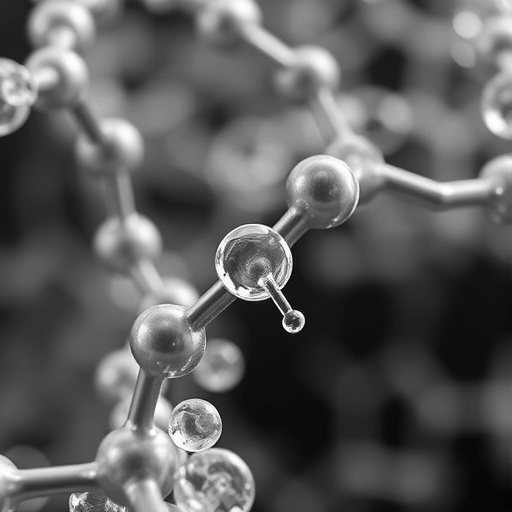In a groundbreaking advance that promises to redefine the landscape of synthetic biology and natural product chemistry, researchers have uncovered a novel biosynthetic pathway responsible for the production of azetidine-containing amino acids. This discovery, centered on the transformative roles of non-haem iron-dependent enzymes, sheds light on a biochemical process hitherto poorly understood, paving the way for new methods of synthesizing these elusive, strained ring structures with significant pharmaceutical potential.
Azetidines, characterized by their four-membered nitrogen-containing rings, have long intrigued chemists due to their unique structural features and inherent ring strain, which endows them with exceptional reactivity and biological activity. Traditionally, the synthesis of azetidine-containing compounds has posed a formidable challenge, hindered by the difficulty of constructing such highly strained cyclic systems in aqueous biological environments. The elucidation of natural enzymatic machinery capable of forging these bonds is not only a milestone in understanding microbial metabolism but also a beacon for innovative drug design strategies.
The team spearheaded by Du, Y., Thanapipatsiri, A., Blancas Cortez, J.J., and colleagues, utilized a suite of cutting-edge genomic and biochemical tools to isolate and characterize a distinct class of non-haem iron-dependent enzymes. These enzymes appear to orchestrate the complex series of oxidative transformations required to cyclize linear amino acid precursors into azetidine frameworks. Unlike their haem-containing counterparts, these non-haem iron enzymes incorporate iron centers embedded within a protein scaffold that fosters unique reactivity profiles tailored specifically for ring formation.
Their investigation revealed that these enzymes exploit an iron(IV)-oxo intermediate to abstract hydrogen atoms and facilitate intramolecular C–N bond formation, a mechanism emblematic of robust oxidative catalysis. The discovery is noteworthy because it provides tangible evidence of nature’s ability to harness radical intermediates in the synthesis of structurally constrained heterocycles, which previously had no confirmed biosynthetic pathways. This insight cascades into a broader understanding of how enzymatic systems can be engineered or mimicked synthetically.
Structural analysis using X-ray crystallography and cryo-electron microscopy provided vivid snapshots of the enzyme active sites, illustrating the delicate interplay between substrate positioning and iron coordination environment required to promote azetidine ring closure. These static views offer a molecular blueprint for rational enzyme redesign, potentially enabling the tailoring of enzymatic activity toward the synthesis of diverse azetidine derivatives with customized functions.
Beyond structural characterization, kinetic studies demonstrated that the enzymatic reaction proceeds with remarkable efficiency and selectivity under physiological conditions. This contrasts starkly with classical chemical methods requiring harsh reagents and elevated temperatures. Such enzymatic finesse underscores a paradigm shift where complex synthetic transformations can be achieved sustainably and with exquisite stereocontrol, aligning with the principles of green chemistry.
Biologically, azetidine-containing amino acids have been implicated in a variety of natural products exhibiting antibiotic, anticancer, and neuroactive properties. Understanding their biosynthesis via non-haem iron-dependent enzymes opens up new research avenues to explore their roles in microbial ecology and host interactions. This could lead to the discovery of novel bioactive compounds and inspire the biosynthetic incorporation of azetidine motifs in therapeutic peptides and proteins.
From a pharmaceutical perspective, the enzymatic access to azetidine scaffolds could revolutionize drug discovery pipelines. Azetidine rings are prized medicinal chemists’ tools capable of modulating molecular rigidity, improving metabolic stability, and enhancing target binding affinity. Harnessing biosynthetic enzymes to install these motifs directly, or deploying engineered variants in synthetic biology platforms, promises accelerated timelines and expanded chemical diversity in lead compound development.
The research also highlights the expanding repertoire of non-haem iron enzymes, confirming their versatility beyond canonical roles in hydroxylation and demethylation. By uncovering their capacity to mediate ring-forming transformations, the study broadens our appreciation of metalloenzyme catalytic diversity and the untapped potential encoded within microbial genomes.
Further inquiries are necessary to delineate the full spectrum of substrates accepted by these enzymes and to engineer improved variants with altered substrate specificity or enhanced turnover rates. Combining evolutionary protein engineering with directed evolution and machine learning could expedite the development of tailor-made catalysts designed to synthesize unconventional amino acid analogs incorporating azetidine and related heterocycles.
This discovery exemplifies the synergy of interdisciplinary approaches integrating bioinformatics, enzymology, structural biology, and organic chemistry to unravel complex biosynthetic enigmas. It also reinforces the importance of exploring microbial metabolic pathways to uncover innovative biocatalysts that can be harnessed for industrial and therapeutic applications.
In summary, the identification and mechanistic elucidation of non-haem iron-dependent enzymes mediating azetidine amino acid biosynthesis mark a transformative step in the understanding of natural product biosynthesis. These findings not only solve a long-standing puzzle about the enzymatic origins of azetidine rings but also unlock promising routes for sustainable synthesis of valuable, strain-rich cyclic amino acids with far-reaching implications in chemistry and medicine.
As the field moves forward, it will be exciting to witness how this newfound enzymatic chemistry is applied to the generation of novel molecular architectures, enabling next-generation therapeutics and materials. The discovery serves as a vivid testament to the hidden chemical ingenuity residing in nature’s enzymatic toolkit and foreshadows a new era of bioinspired catalysis capable of delivering complex ring systems that have eluded synthetic chemists for decades.
Subject of Research: Azetidine amino acid biosynthesis mediated by non-haem iron-dependent enzymes
Article Title: Azetidine amino acid biosynthesis by non-haem iron-dependent enzymes
Article References:
Du, Y., Thanapipatsiri, A., Blancas Cortez, J.J. et al. Azetidine amino acid biosynthesis by non-haem iron-dependent enzymes. Nat. Chem. (2025). https://doi.org/10.1038/s41557-025-01958-x
Image Credits: AI Generated




